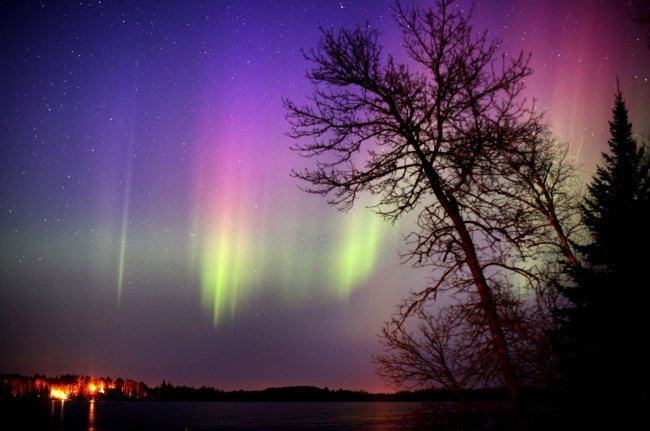
MINNEAPOLIS ― The northern lights rise like glowing pillars and then unfurl to stretch across the night sky. They wave like a flag, shimmering green with purple at the fringes, below a tapestry of stars. Sometimes they transform nearly the whole sky into their dance floor, flitting north and south in hues from blue to yellow and even pink and red. The beauty is astounding; it’s almost surreal.
Or so I’ve been told.
The aurora borealis ― and its southern counterpart, the aurora australis ― starts when the sun has a solar flare or coronal mass ejection and hurls charged particles across the heavens. Given the right trajectory, those particles can get trapped by Earth’s magnetic field and collide with gases in the upper atmosphere as they zoom toward the poles. It’s such energetic collisions that give the night sky its luminous glow. The sun has its own cycles, akin to our seasons, and is currently in the midst of heightened solar flare activity. Another such period won’t return for nine to 14 years.
Nonscientific translation: This is the year of aurora borealis. I hope.
Seeing the northern lights can be a tricky thing. Particle storms from solar flares take 48 hours to arrive at our humble place in the universe. There are some 90 million miles between the sun and the Earth, affording opportunities for the storms to lose energy or veer off course. Even if they stay on track, they can arrive during daylight hours, when the high-energy, high-altitude show carries on unseen by human eyes. Or a storm can arrive at night, only to have its otherworldly displays masked by worldly clouds.
Early detection of solar flares, though, is my ticket to the night sky show because it allows scientists to predict the occurrence of northern lights.
Travis Novitsky, a worker at Grand Portage State Park, just 500 feet south of the Canadian border, has been an avid northern lights viewer and photographer for 20 years.
“We had a promising forecast just a few days ago. Space weather forecasters were saying there was a 90 percent chance, but it never materialized ― and we actually had clear skies,” he said. It was the case of an “empty cloud.” The sun had emitted a plasma, but it didn’t contain the stuff of colorful shows.
Novitsky said that he always heads north of any town. Even the lights from a town as small as Grand Marais, Minn. can wash out all but the brightest aurora display.
He situates himself on the south shore of a lake or an open meadow or any place with a wide-open view to the north.
He also says that there is little truth to the notion that winter produces more lights. The conditions that generate auroras occur year-round, but “in the winter our chances are greater, theoretically, because we have more nighttime hours.
His last really good sighting, he says, was last October, when clear skies coincided with a solar flare. He believes the heightened sun activity started a few years ago; 2012 was a good year, he said.
Because Novitsky has seen so many displays, I asked him a question that has nagged me for a while. Last summer, I was staying at Ludlow’s Island Resort in a cabin called “Northern Lights,” whose bedrooms face north over Lake Vermilion. At midnight, there was a long period of flickering in the sky. The flicker, though, was white. Had I seen the northern lights, or heat lightning, as I’d eventually convinced myself?
“Very little question in my mind,” Novitsky said. “You saw the northern lights.”
He explained that when displays are weak, the green of the auroras often registers as white to the human eye (but green on film, which is more sensitive to the color spectrum).
His judgment shocked and pleased me, but it hasn’t diminished my drive to see the northern lights again ― next time, in all their colorful glory.
By Kerri Westenberg
(Star Tribune)
(Minneapolis)
Or so I’ve been told.
The aurora borealis ― and its southern counterpart, the aurora australis ― starts when the sun has a solar flare or coronal mass ejection and hurls charged particles across the heavens. Given the right trajectory, those particles can get trapped by Earth’s magnetic field and collide with gases in the upper atmosphere as they zoom toward the poles. It’s such energetic collisions that give the night sky its luminous glow. The sun has its own cycles, akin to our seasons, and is currently in the midst of heightened solar flare activity. Another such period won’t return for nine to 14 years.
Nonscientific translation: This is the year of aurora borealis. I hope.
Seeing the northern lights can be a tricky thing. Particle storms from solar flares take 48 hours to arrive at our humble place in the universe. There are some 90 million miles between the sun and the Earth, affording opportunities for the storms to lose energy or veer off course. Even if they stay on track, they can arrive during daylight hours, when the high-energy, high-altitude show carries on unseen by human eyes. Or a storm can arrive at night, only to have its otherworldly displays masked by worldly clouds.
Early detection of solar flares, though, is my ticket to the night sky show because it allows scientists to predict the occurrence of northern lights.
Travis Novitsky, a worker at Grand Portage State Park, just 500 feet south of the Canadian border, has been an avid northern lights viewer and photographer for 20 years.
“We had a promising forecast just a few days ago. Space weather forecasters were saying there was a 90 percent chance, but it never materialized ― and we actually had clear skies,” he said. It was the case of an “empty cloud.” The sun had emitted a plasma, but it didn’t contain the stuff of colorful shows.
Novitsky said that he always heads north of any town. Even the lights from a town as small as Grand Marais, Minn. can wash out all but the brightest aurora display.
He situates himself on the south shore of a lake or an open meadow or any place with a wide-open view to the north.
He also says that there is little truth to the notion that winter produces more lights. The conditions that generate auroras occur year-round, but “in the winter our chances are greater, theoretically, because we have more nighttime hours.
His last really good sighting, he says, was last October, when clear skies coincided with a solar flare. He believes the heightened sun activity started a few years ago; 2012 was a good year, he said.
Because Novitsky has seen so many displays, I asked him a question that has nagged me for a while. Last summer, I was staying at Ludlow’s Island Resort in a cabin called “Northern Lights,” whose bedrooms face north over Lake Vermilion. At midnight, there was a long period of flickering in the sky. The flicker, though, was white. Had I seen the northern lights, or heat lightning, as I’d eventually convinced myself?
“Very little question in my mind,” Novitsky said. “You saw the northern lights.”
He explained that when displays are weak, the green of the auroras often registers as white to the human eye (but green on film, which is more sensitive to the color spectrum).
His judgment shocked and pleased me, but it hasn’t diminished my drive to see the northern lights again ― next time, in all their colorful glory.
By Kerri Westenberg
(Star Tribune)
(Minneapolis)
-
Articles by Korea Herald





![[Herald Interview] Mom’s Touch seeks to replicate success in Japan](http://res.heraldm.com/phpwas/restmb_idxmake.php?idx=644&simg=/content/image/2024/04/29/20240429050568_0.jpg&u=)



![[News Focus] Lee tells Yoon that he has governed without political dialogue](http://res.heraldm.com/phpwas/restmb_idxmake.php?idx=644&simg=/content/image/2024/04/29/20240429050696_0.jpg&u=20240429210658)









![[Today’s K-pop] Seventeen sets sales record with best-of album](http://res.heraldm.com/phpwas/restmb_idxmake.php?idx=642&simg=/content/image/2024/04/30/20240430050818_0.jpg&u=)